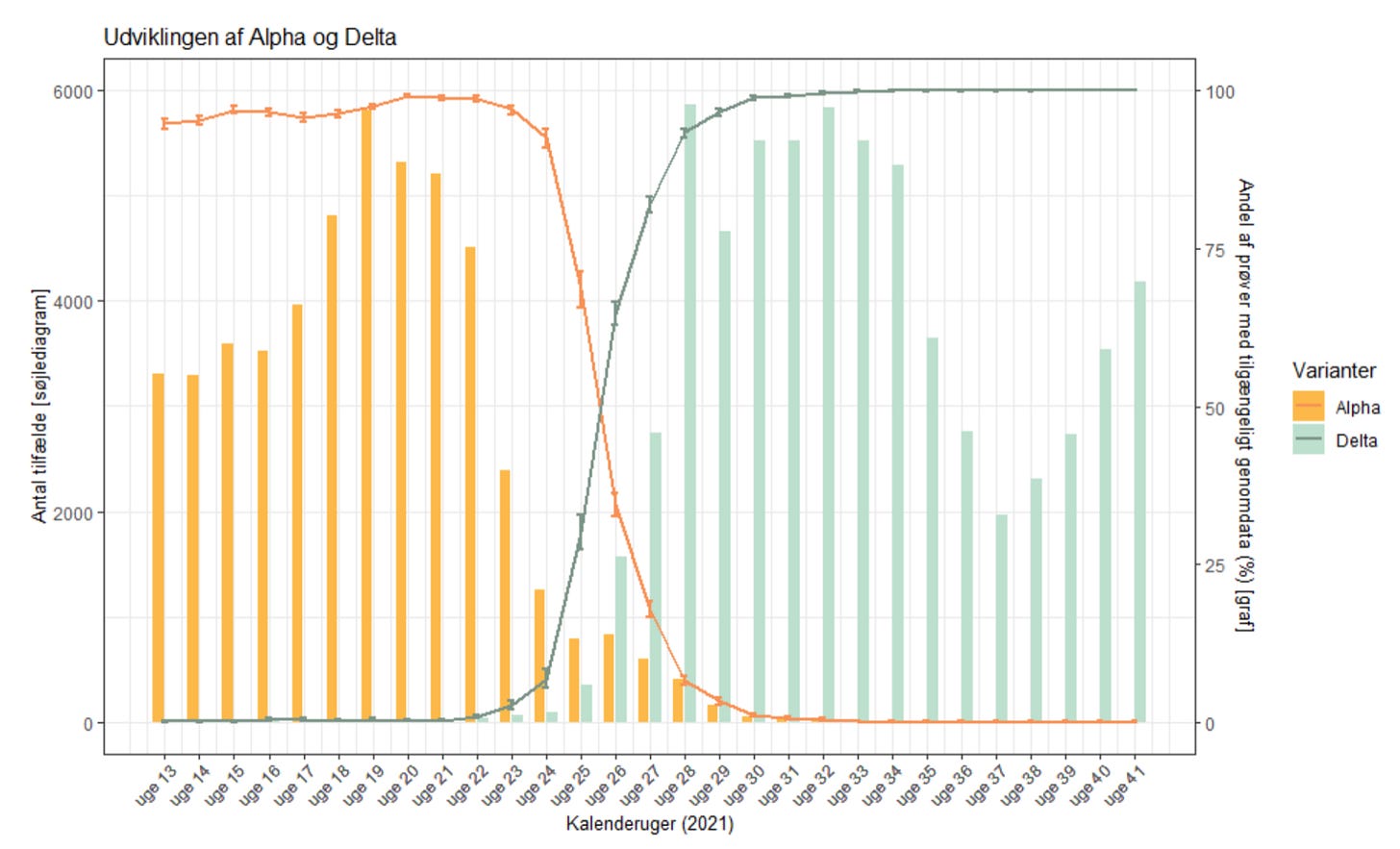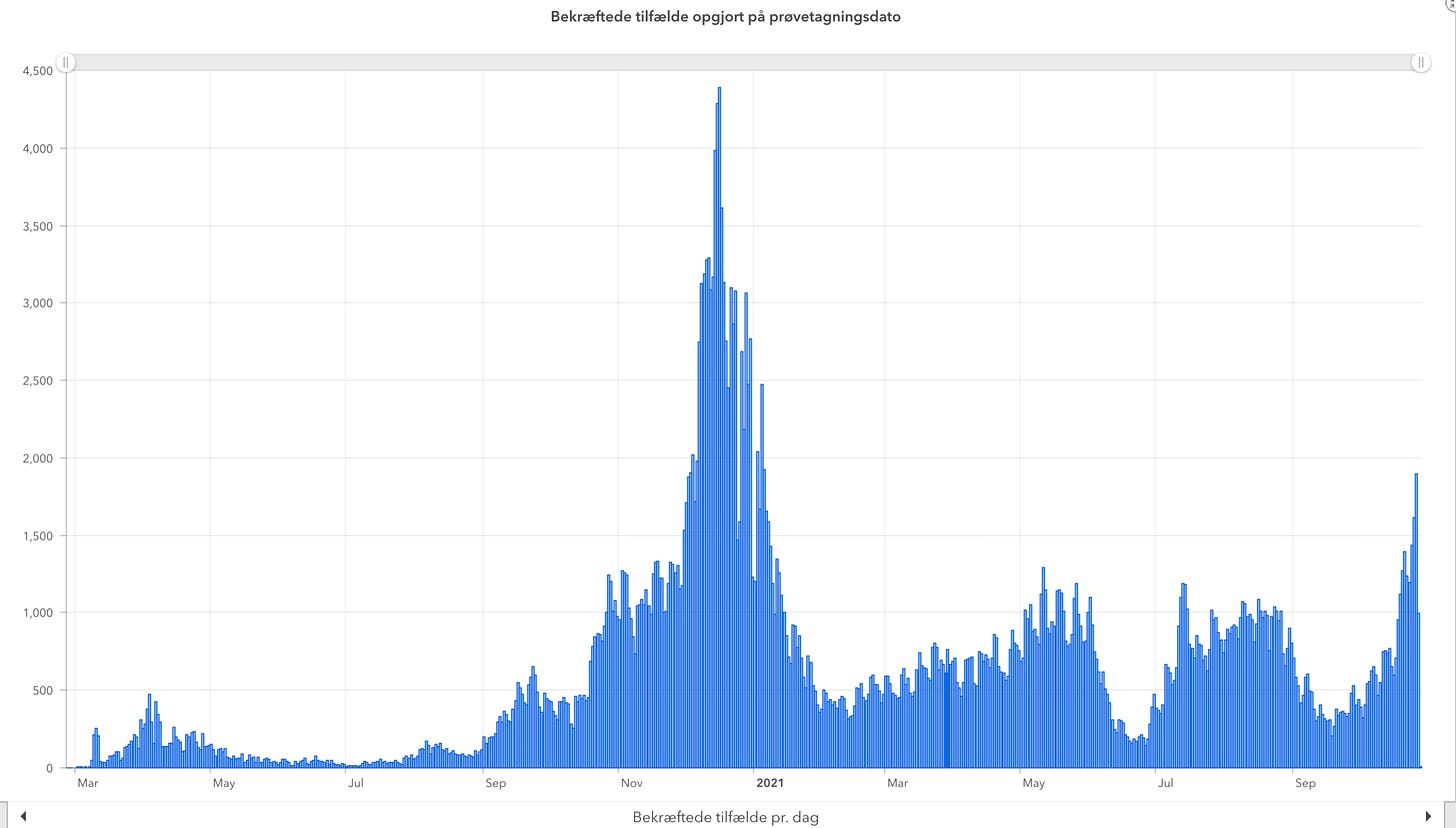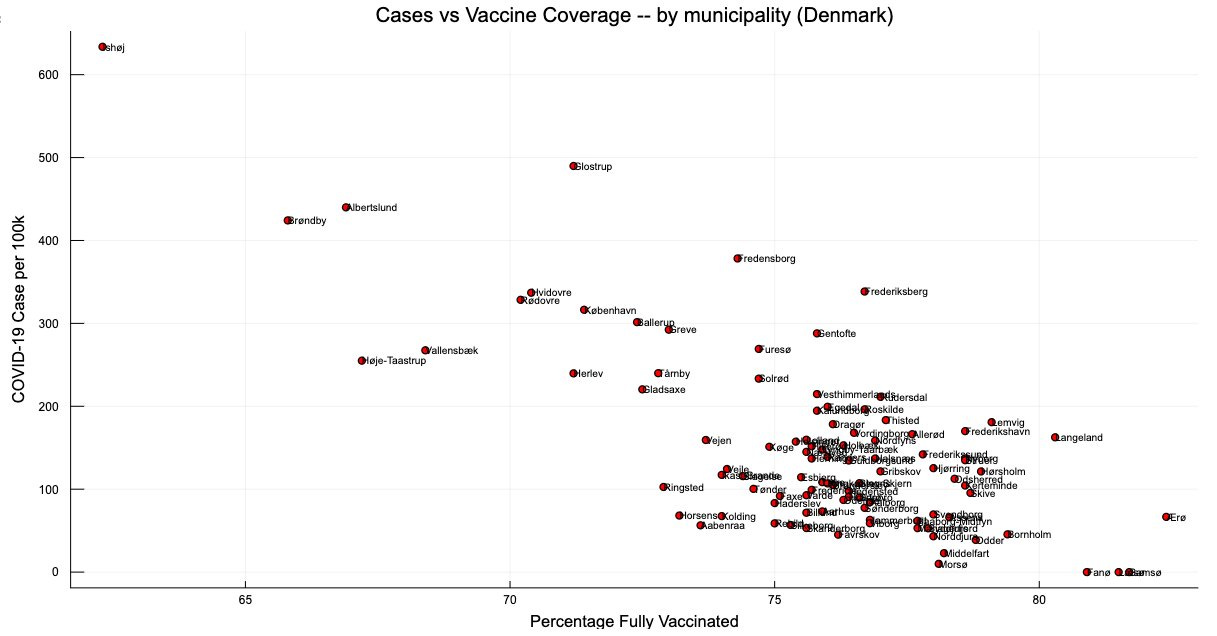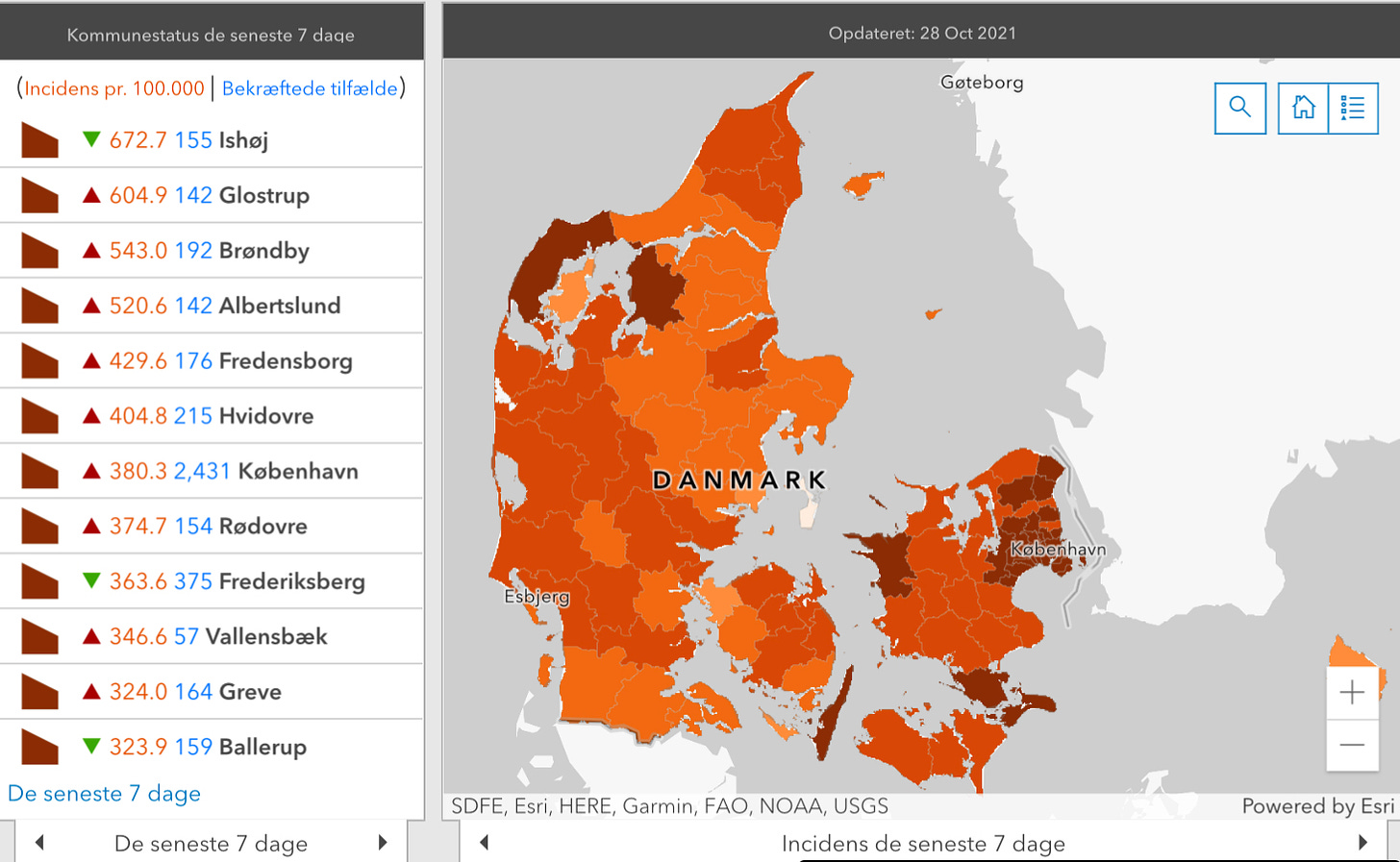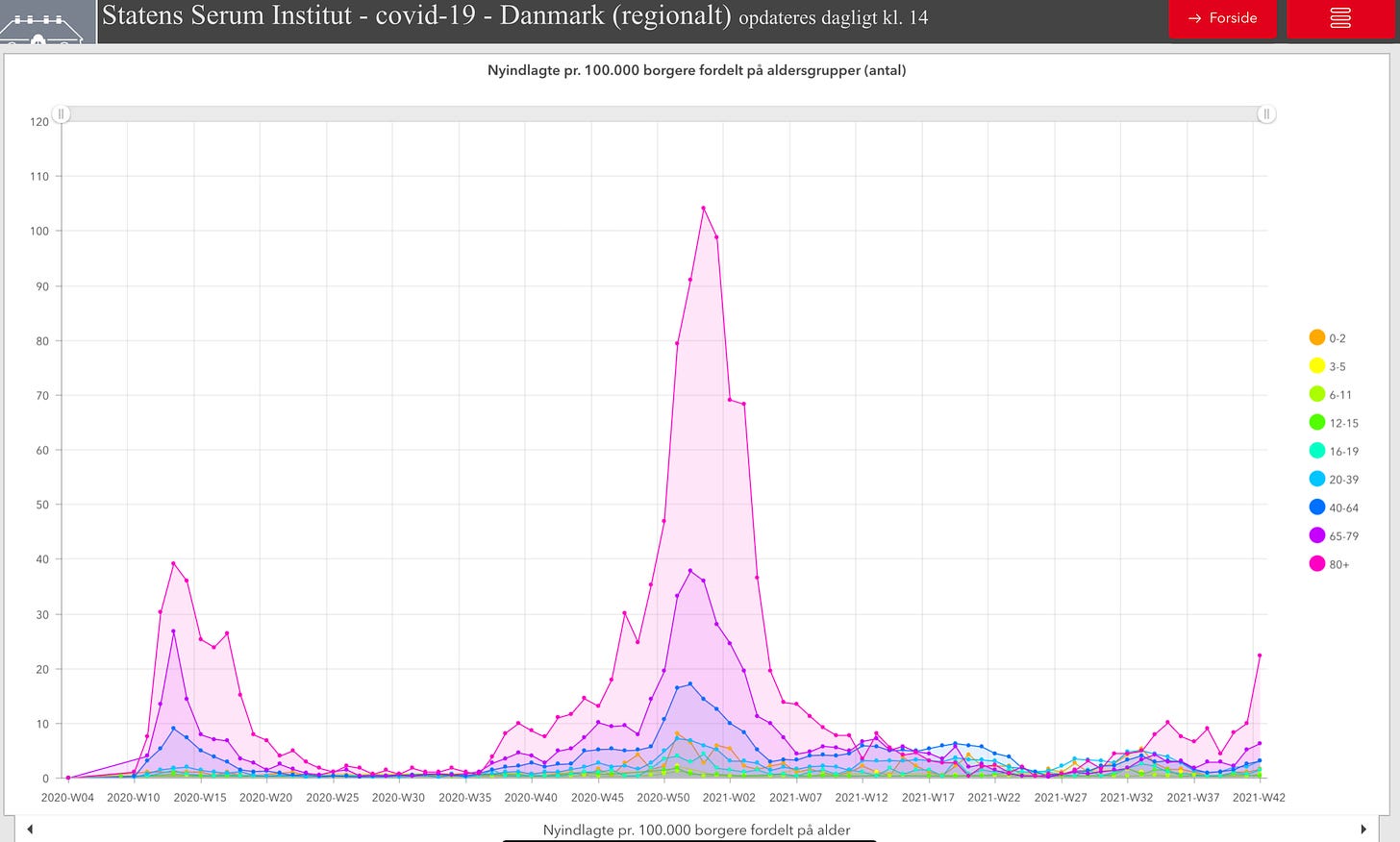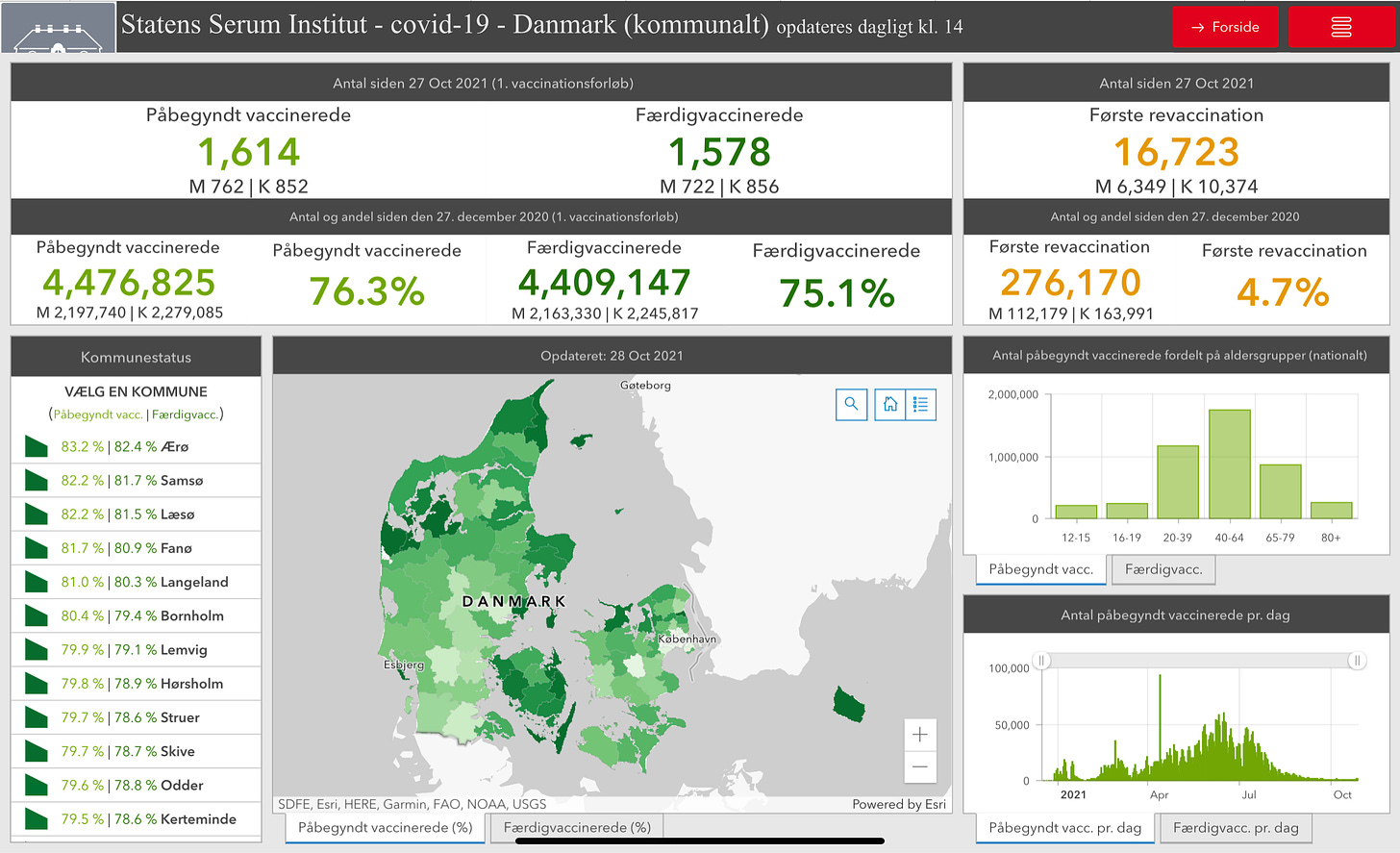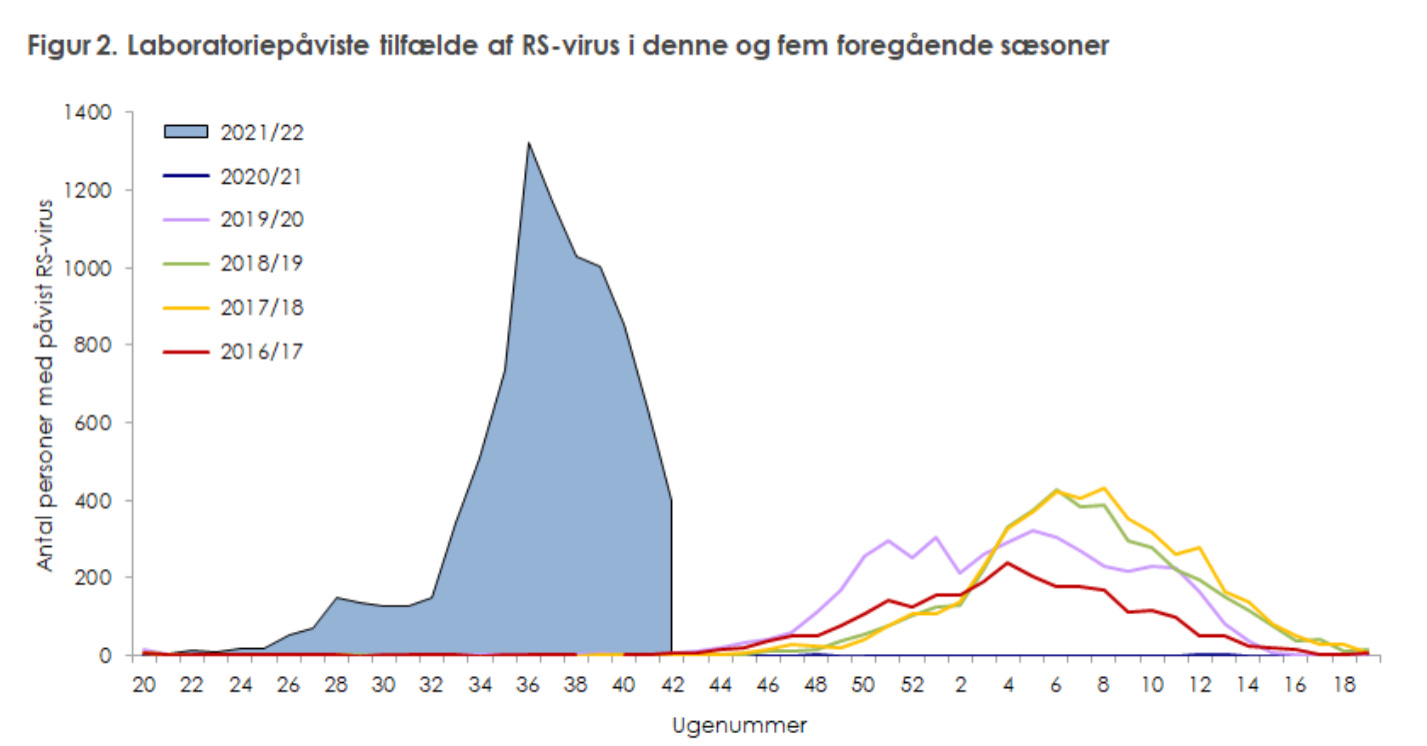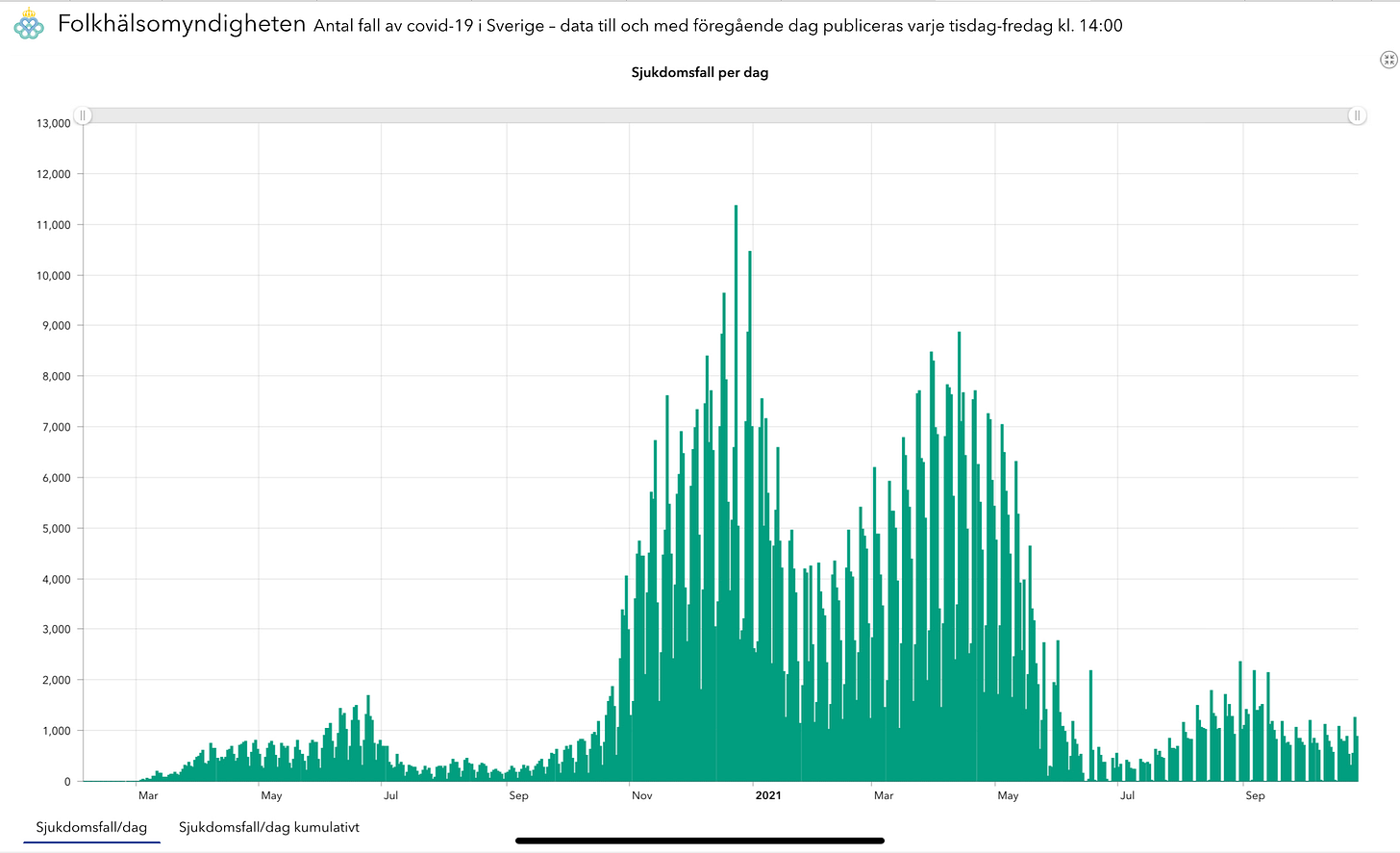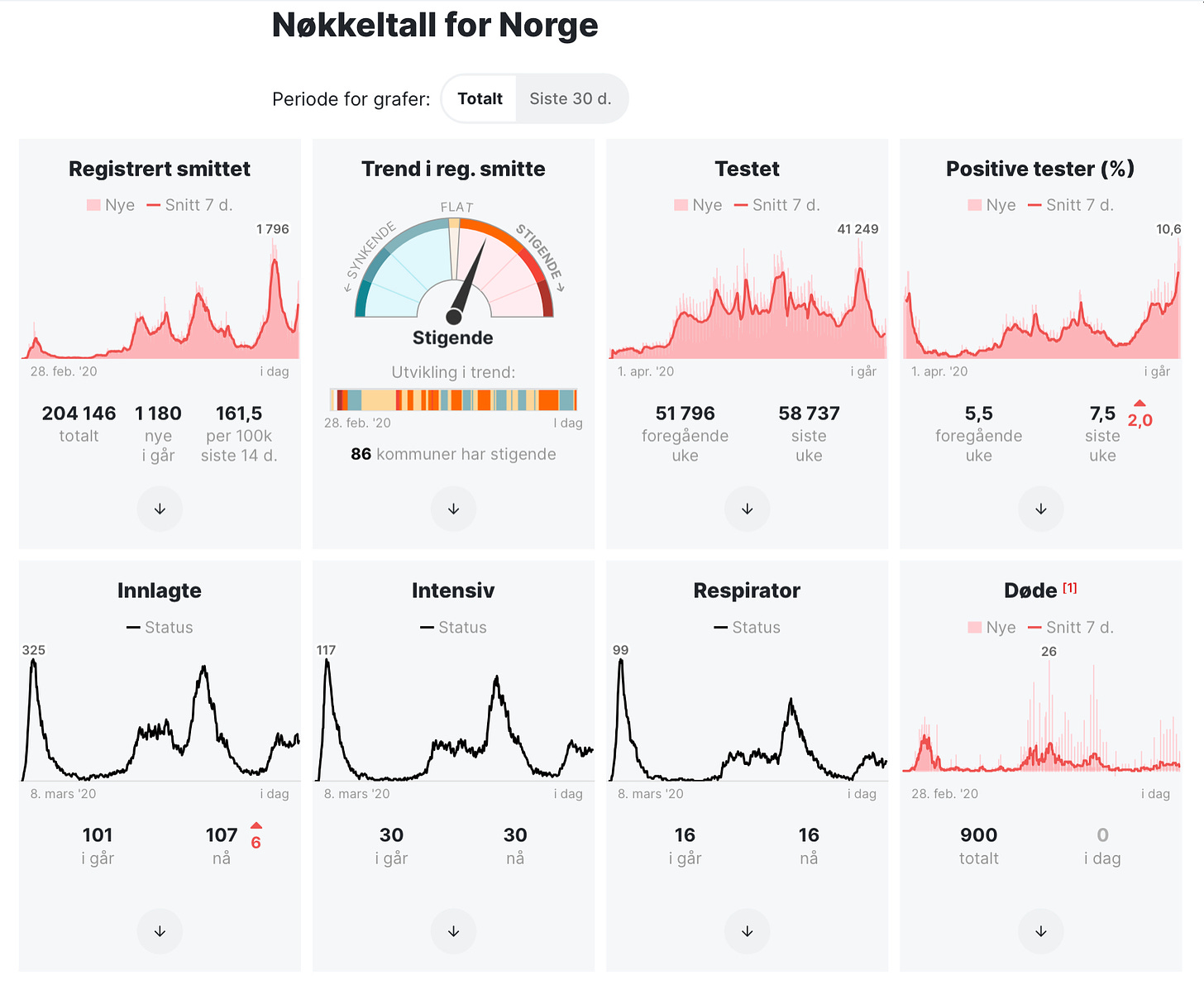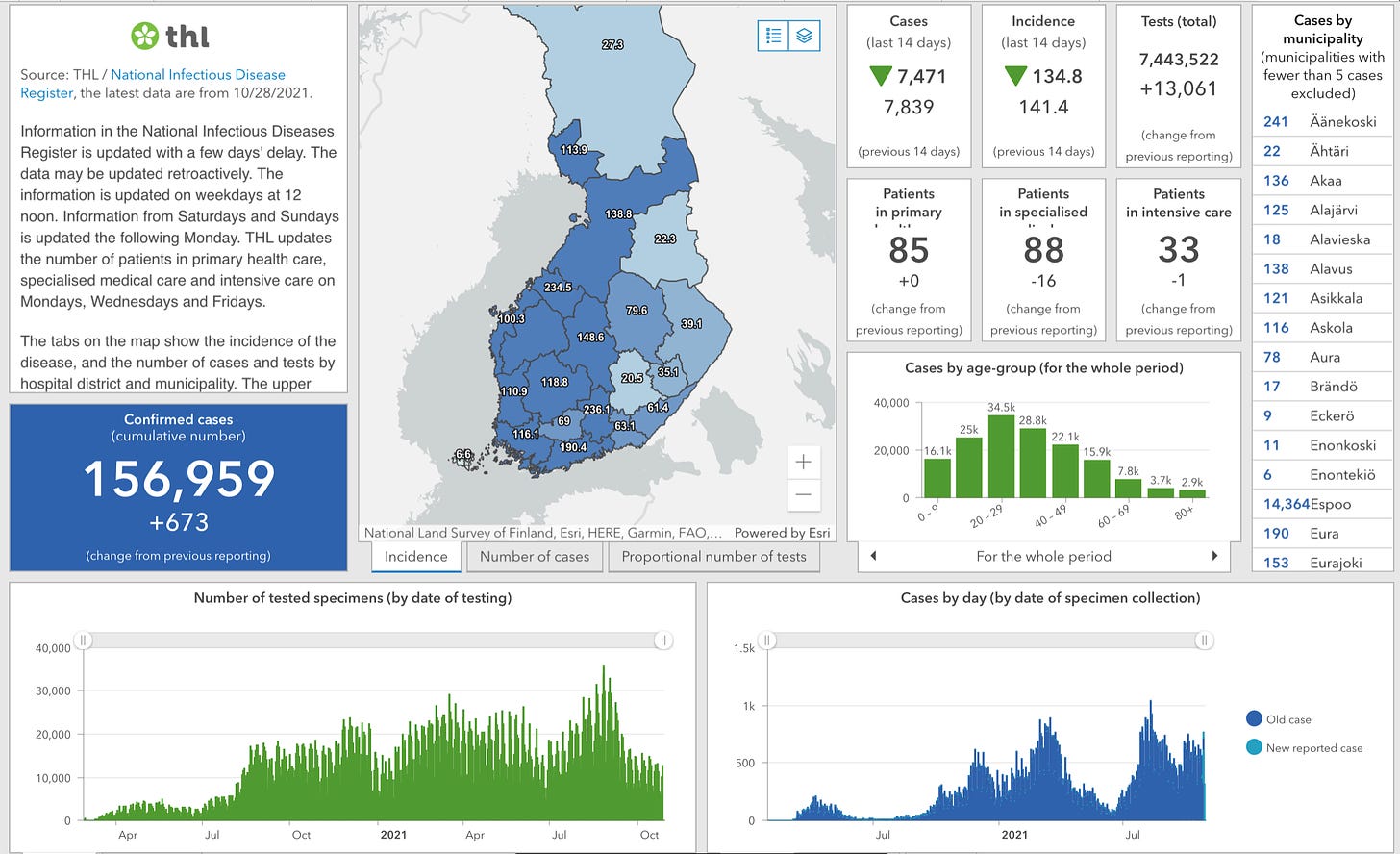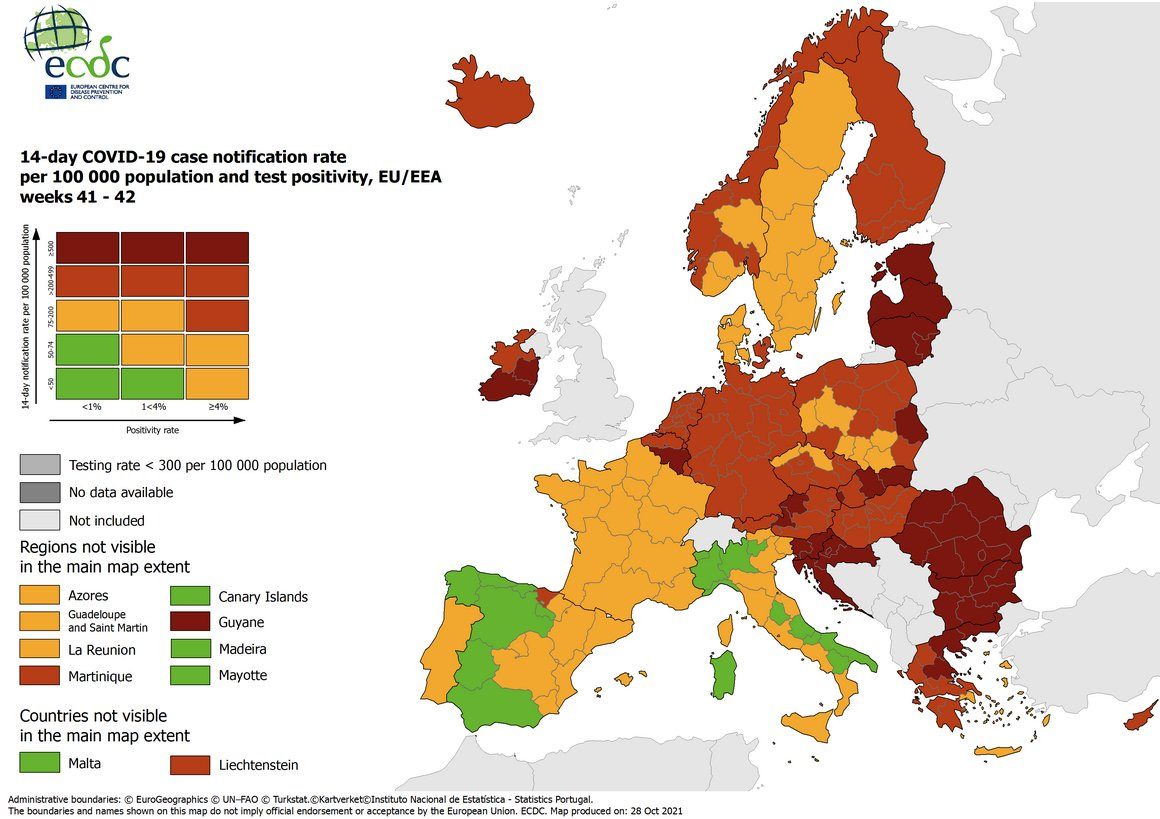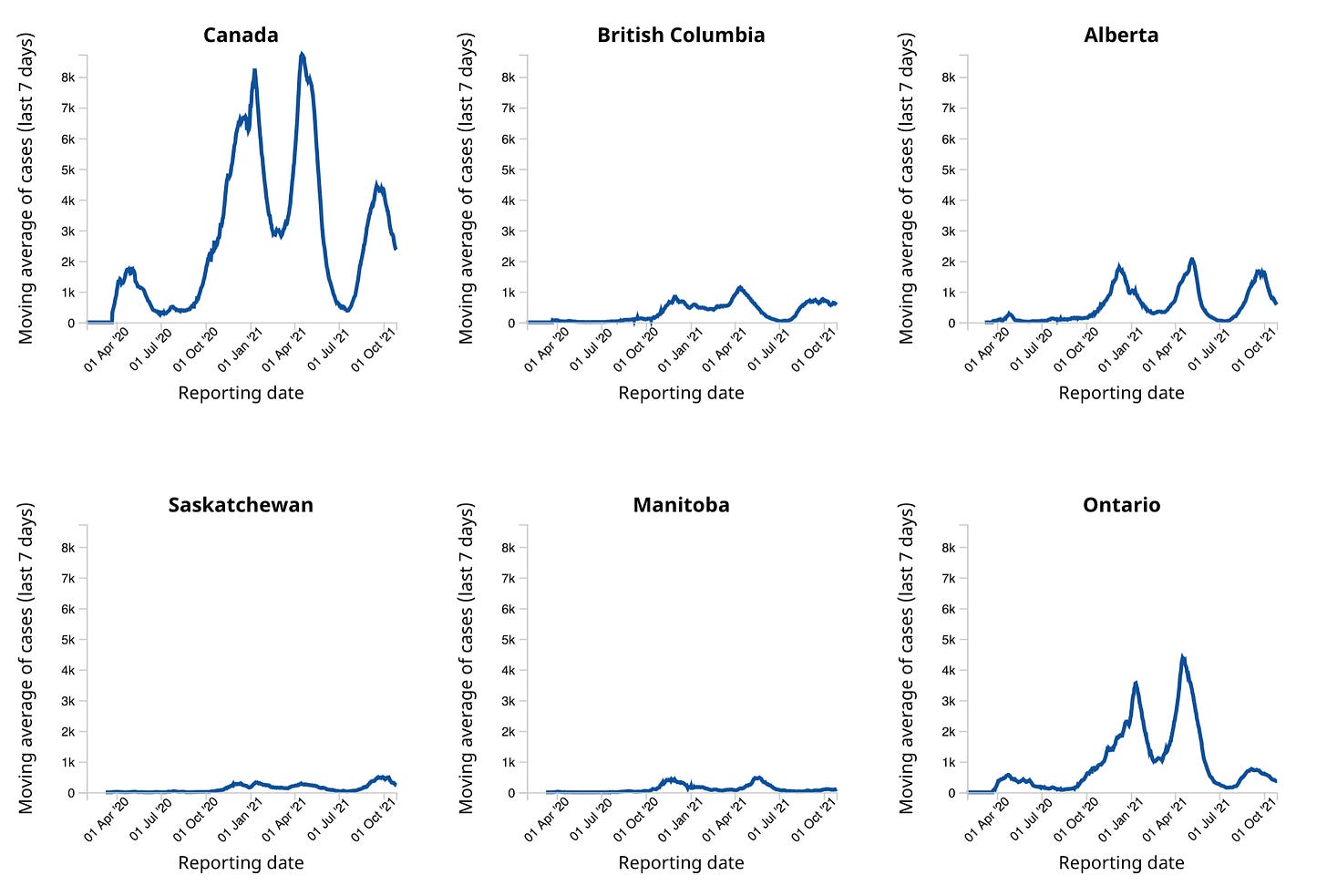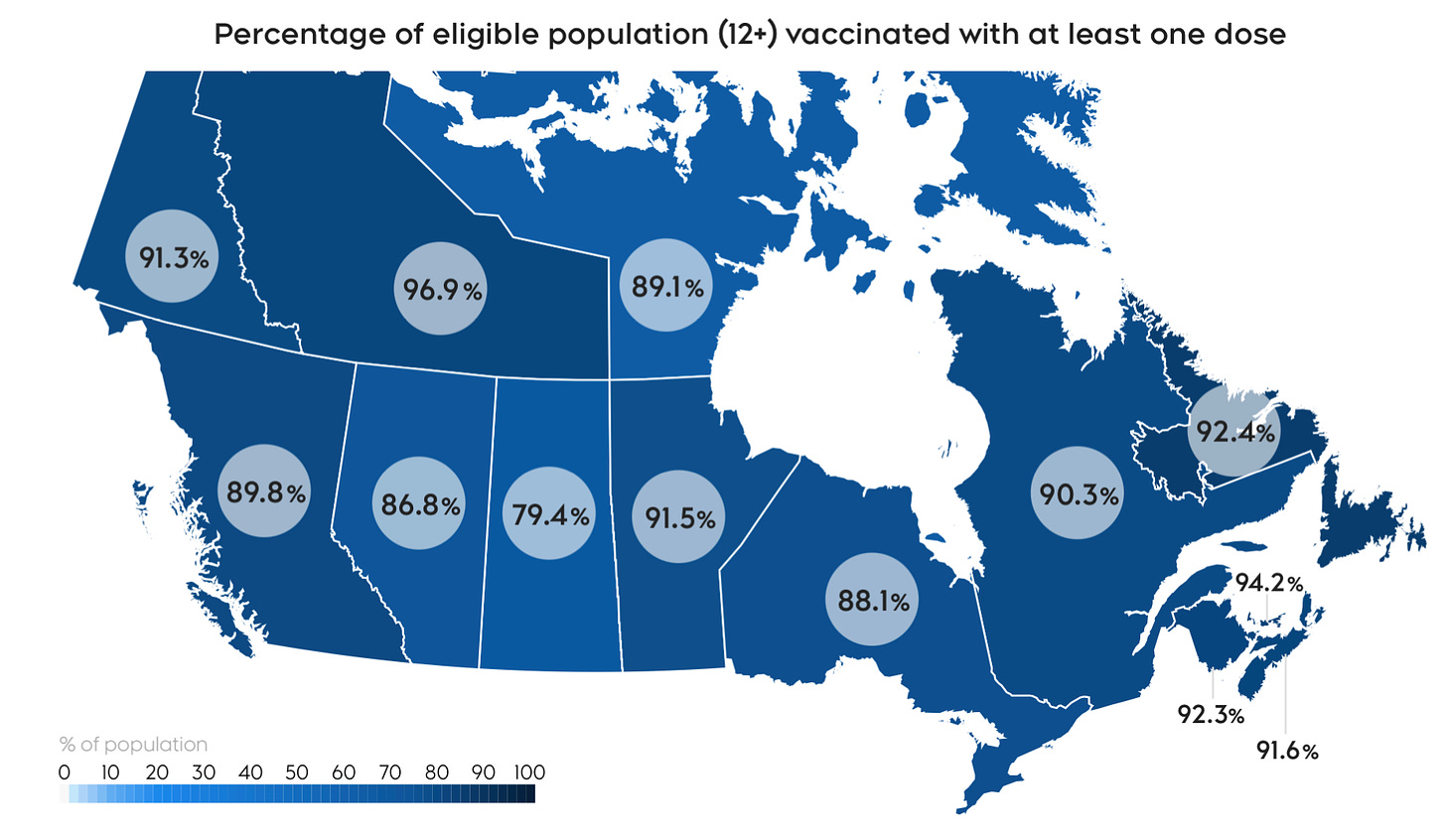🇩🇰
“It's going the wrong way with the COVID epidemic right now.”
That is from a new weekly epidemiological trend report published for the first time by the Staten Serum Institut. It says COVID cases in Denmark increased by a whopping 73% from week 41 to week 42. Also concerning it says that in spite of increased testing, the positivity percentage went from 1.6% to 2.2% from one week to the next.
Ward Doctor Rebecca Legarth:
"The epidemic is currently growing rapidly across the country. This is most pronounced in the Capital Region, where the positive percentage is also significantly higher than in the other regions. In parallel, the number of newly admitted COVID patients in hospitals is increasing. However, it is important to note that the number of new admissions per 100,000 is significantly higher among unvaccinated people than among the vaccinated.”
Hospital admissions rose from 163 to 246 week over week. The report found that among them was a “large proportion” of breakthrough infections. Among patients 20 to 59 years old, 29% were fully vaccinated. For those 60 years old or older, the number was 84%.
-
Today Health Minister Magnus Heunicke will hold a meeting involving the parliamentary parties for a robust briefing on the COVID situation as numbers rocket upward. However, broad restrictions will not be on the table, according to several of the parties attending.
Konservative Folkeparti Health Policy Spokesman Per Larsen spoke to DR:
“But in some more specific areas, where the number of infections is very high and the vaccination rate may not be so high, the Danish Agency for Patient Safety and the municipalities can agree on what is to take place. But I do not envisage any general restrictions.”
Liselott Blixt with the Dansk Folkeparti echoed the sentiment:
“We can not support having to wear masks again, or that there are businesses that need to be closed down. But we can agree to local initiatives if we see that infections are exploding, but not nationwide restrictions that make it difficult to have a daily life.”
While the appetite is low for reintroducing broad restrictions and having more lockdowns, the country’s testing capacity will be getting a boost. In a TV interview Wednesday night, Magnus Heunicke said they will be increasing the number of daily tests.
“Today we have decided to scale up the testing. Today we have a level of 100,000 tests a day. Yesterday we tested 93,000, so we are very close to that. We are adding 50,000 on top of that now, so we will reach the capacity of 150,000 daily tests.”
The COVID testing regime in Denmark has been seriously scaled down from what it once was. At the height of the pandemic, there were over 700,000 tests being conducted daily. In the last few months that has fallen below 100,000. As well, rapid testing sites across the country have been closed and access to quick tests has been severely limited.
-
Danish Health Minister Magnus Heunicke gave an update on the COVID variant front today. He says while the Delta variant is “all-dominant” it has branched out into a number of sub-variants.
“Some of these may prove to be more contagious, which is why we monitor all sub-variants closely. AY.4.2 is one of the sub-variants. It now amounts to approx. 10% of the positive samples in the UK. In Denmark we found it for the first time on August 4. We see approximately 10 new cases per week. It is not rising, so right now we are not worried, but we are following it closely, both in terms of spread and properties.”
Heunicke says Denmark screens a very high number of positive test results in order to be vigilant on the variants, and strains thereof, that are circulating. He says in week 41 alone 84% of all positive tests were sequenced.
“It gives us a very accurate overview of the epidemic compared to other countries. Detects new ones early and can follow them closely. But national surveillance cannot stand alone. If a new and more contagious variant emerges, it will in all probability happen abroad. Therefore, we also follow international developments closely.”
He finishes by saying that health authorities are in the process of analyzing the sub-variant AY.4.2 in more detail.
The strain is thought to be a possible culprit behind a new surge in infection numbers in the United Kingdom.
-
In the latest variant update from the Staten Serum Institut, the Delta variant does indeed remain all dominant. It accounted for almost every single positive infection in Denmark except one in week 42. A single case of the Gamma variant has been identified. The Gamma variant, otherwise known as P1, is a strain that was first identified in Brazil. This is the first confirmed case of a variant other than Delta in Denmark in about two months.
Currently, the SSI has detected and identified almost 50 different sub-variants of the Delta strain. The most worrisome one at the moment, AY.4.2, has a total of 253 confirmed cases to date.
-
Denmark is reporting 1,847 COVID infections and one more coronavirus death in the last day. This is the ninth straight day of daily case numbers exceeding 1,000, as the country looks to be in its highest infection wave since the Alpha variant arrived last winter.
There were 114,862 total corona tests on Wednesday, of which 88,947 were PCR tests, which equals a positivity percentage of 2.07%, which is very high.
-
Professor Peter Hansen, a Dane who is currently an economics professor at the University of North Carolina, has published an interesting graph plotting the infections vs vaccinations situation of each municipality in Denmark. Hansen is a specialist in forecasting and volatility modeling.
Take a look at Ishøj compared to all other kommunes.
-
Ishøj Kommune says it administered some 800 COVID tests yesterday as the municipality battles soaring infection rates. Trying to find a silver lining, in a Facebook post, the Kommune said it now has the highest testing rate in Denmark. It stresses that everyone needs to get tested and for those that haven’t yet they also need to get vaccinated “if we are to limit the infection in our municipality.”
-
There are now 70 Danish kommunes with COVID incidence rates above 100 per 100,000 residents as the country continues to sink into deeper shades of orange and red.
17 of those municipalities have incidence rates above 300.
-
COVID hospitalizations (212) continued to climb (+12) while the number of infected people in an ICU (24) inched upward (+1) and of those, the number on a ventilator (13) also increased slightly (+1).
-
On the vaccination effort, a mini uptick of 1st and 2nd doses administered continues for a 2nd day with both above 1,000. The lion’s share of inoculations yesterday remained booster shots, 16,723.
To date, 76.3% of the total population has one dose and 75.1% have both.
-
On the RS virus front, the number of cases has dropped for a sixth week in a row. In week 42 there were just 399 confirmed cases, which is down from 635 the week before and 853 the week prior to that. The number of hospital admissions due to the virus has dropped from 285 to 154 in the last six weeks.
However, the RS virus positive percentage in week 42 was 18%, which is concerning, but it is worth noting that too is on a steady decline from being over 40% just a few weeks ago.
-
On the seasonal flu front, numbers remain low, with just 15 confirmed cases in week 42. Denmark is one month in on a massive influenza vaccination campaign. It is targeting priority groups like seniors, vulnerable populations, and for the first time ever, children between two and six years old. But it will soon open up access to flu shots for the general public.
🇸🇪
Sweden has added 892 infections and two more corona deaths since yesterday’s update.
On vaccinations..
Population 16 years old and older - 7,248,761 1st doses (84.9%) and 6,891,779 2nd vaccine doses (80.7%) administered
12 to 15 year olds - 118,280 total inoculations to date (24%)
Booster shots - 135,389 3rd doses given so far (22%)
-
The results of another seroepidemiological study in Sweden have determined that more than three-quarters of the population have coronavirus antibodies. This is according to the Swedish Public Health Agency, who conducted the study by testing blood samples from donors and surplus samples from outpatients.
On average, it says, 76% of the samples were found to have antibodies indicating either vaccination or previous infection. The rate was highest in samples from people 65 years old and older were highest at 89% and lowest for those 19 years old and young, 42%.
Unit Managed Mia Brytting:
“The high vaccination coverage is the single most important factor behind the fact that we see a sharp and expected increase in the prevalence of antibodies in the age group of 20-64 years old. The very high proportion of antibodies is also found in the age group of 65-95 years old.
-
The Swedish Public Health Agency has expanded a recommendation on incoming travelers getting tested. Currently, travelers six years old and older who are not vaccinated or have had a prior infection are recommended to get a COVID test on arrival, regardless of whether they are symptomatic or not. Now the agency has made the added recommendation that even fully vaccinated people traveling into Sweden get tested if they develop symptoms within 14 days of entry.
🇳🇴
Norway added 1,592 infections and five more pandemic deaths since yesterday’s update.
COVID hospitalizations (107) are up (+6) while ICU (30) and ventilator (16) numbers are both unchanged.
To date, 77.92% of Norwegians 12 years old and older have had one vaccine dose and 69.15% have had both.
-
The Norwegian Institute for Public Health has released new modeling that tables two possible scenarios ahead. The agency stresses many variables are making modeling uncertain. Those variables include new variants(s), the seasonal effect, and social contacts among the population.
The first scenario assumes social contacts remain low, in line with what they were prior to all COVID restrictions being lifted on September 25. It also anticipates reaching a vaccination rate of 90% for those 12 years old and older. Another factor it relies on is at least half of symptomatic people staying home and self-isolating. In that scenario, there is very little, if any, new infection wave.
Scenario two is based on social interactions picking up by about 35%, a lower vaccination rate, and fewer sick people isolating at home. It paints a more severe picture with a significant infection wave in the fall and carrying through the winter. Hospital admissions could reach record highs of 60 to 70 a day.
Department Director Line Vold:
“It is difficult to assess the probability of these scenarios, so it is necessary to prepare ourselves both for a scenario with a fairly well-controlled epidemic, and for a scenario with a higher disease burden in the winter months. We continue to follow the situation and developments closely, obtain information, and use the information to narrow the uncertainty. Based on an overall assessment of the situation, we believe it is most likely that we will get a wave that is not as large as scenario two shows.”
The modeling notes the most important factors to keep numbers down are vaccination coverage, people complying with recommendations, and staying home when sick.
It is also worth noting that Norway is already seeing a fairly serious uptick in infection activity.
🇫🇮
Finland registered 673 infections and four more virus death today.
COVID hospitalizations (206) are down ( -9).
So far, 4,214,076 1st vaccine doses (75.1% of the total population) and 3,815,172 2nd doses (68.2%) have been administered.
-
The national health agency is also noting that over the last two weeks, unvaccinated people between the ages of 12 and 79 years old are being admitted to specialized hospital care at a rate 15 times higher than fully vaccinated people of the same age. For those in the 50 to 69 year old age group, the risk is more than 50 times higher for those unvaccinated compared to those who have both doses.
-
Finnish health officials suspect that the introduction of the EU COVID digital certificate and the requirement to use it to enter restaurants, bars, and other venues has spurred more vaccinations. The Finnish Institute for Health says it is seeing increasing vaccination rates for people under the age of 35. The number of those 12 to 15 years old getting their first dose is also rising.
🇪🇺🦠
The European Centre for Disease Prevention and Control has published its latest weekly map assessing the COVID situation across Europe. The ‘green’ areas continue to shrink.
🌏💉🦠
The World Health Organization is warning that the pandemic is not over yet and that in fact numbers are rising once again.
Director General Dr. Tedros Adhanom Ghebreyesus:
“The global number of reported cases and deaths from COVID is now increasing for the first time in two months, driven by an ongoing rise in Europe that outweighs declines in other regions. It’s another reminder that the pandemic is far from over.”
Dr. Tedros is again blaming a global inequity on vaccines and other tools to fight the pandemic.
“80 times more tests, and 30 times more vaccines, have been administered in high-income countries than in low-income countries. If the 6.8 billion vaccine doses administered globally so far had been distributed equitably, we would have reached our 40% target in every country by now.”
He warned in a Thursday COVID update that unless the pandemic is controlled everywhere in the world, then we risk further mutations of the virus and more and more infection waves.
🦠🌏
The pandemic and the subsequent lockdowns and border closures that have since rolled across the globe have resulted in a record drop in migration. A new report from Organization for Economic Co-operation and Development found global migration to the 38 leading industrialized nations and emerging markets in 2020 fell by 30%. In the United States it saw a 44% drop in new migrants, while in France the decline was 21%. In total, 3.7 million people migrated to wealthier nations last year despite the global pandemic.
🇷🇺
Russia is locking down. Six regions of the country, including the capital Moscow, have been ordered to shut down. Shops, restaurants (except for take-out), and schools will all close. The only things allowed to open are pharmacies and grocery stores. The lockdown is supposed to last for nine days. Russia has been reporting record-high infection and death numbers. It also suffers from very low vaccination rates.
🇨🇦
Canada reported 2,510 COVID infections yesterday while losing another 41 lives to the virus.
On the vaccination front so far, 29,704,027 1st vaccine doses (77.69% of the total population) have been administered while 28,145,533 people (73.61%) are fully vaccinated.
In Ontario today there were 409 new infections, of which 265 were people with one dose or no doses at all. There are 197 people in hospital; of those 169 are either unvaccinated or have a single dose. Of the 132 people in an ICU that number 116.
Quebec reported 478 infections and five more fatalities.
In Atlantic Canada, New Brunswick had 69 infections and two deaths today. Nova Scotia has 31 cases. Newfoundland and Labrador had 20.
Manitoba saw 116 new corona cases and four more deaths today.
There were 237 infections and 11 deaths in Saskatchewan today.
Alberta logged 531 infections and 12 more fatalities today.
B.C. registered 758 more infections and another ten deaths today.




